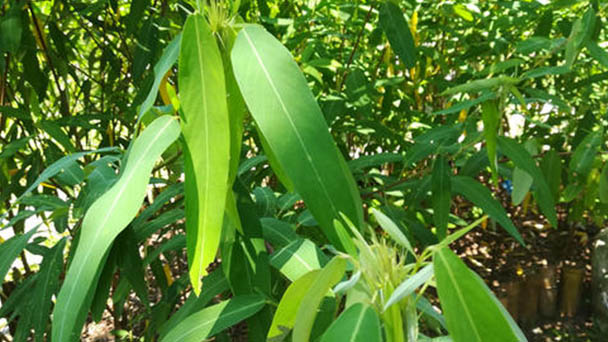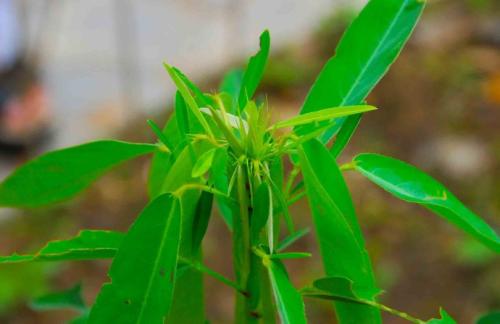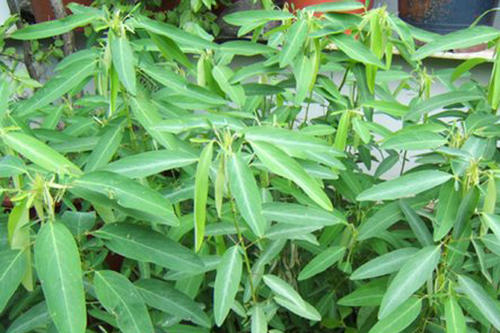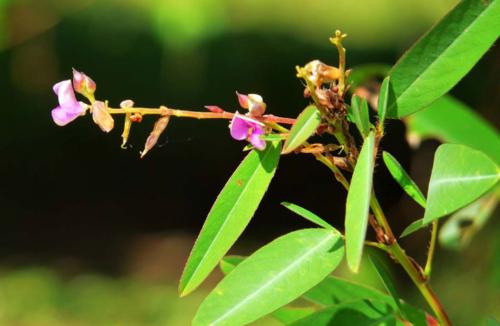Dancing plant (Codariocalyx motorius) profile
Written by Maggie
Aug 31 2021

The Dancing Plant (Codariocalyx motorius), also known as telegraph plant, semaphore plant, is an upright small shrub, reaching a height of 1.5 m. Dancing plant stem is simple or branching, glabrous. Leaves are trifoliate, terminal leaflets long elliptic or lanceolate, lateral leaflets very small, long elliptic or linear or sometimes absent .Inflorescence panicles or racemes terminal or axillary; Corolla is purplish red, pistil 10-12 mm long, ovary puberulent.
Dancing plant picture

Morphological characteristics of dancing plant
Stems
The dancing plant (Codariocalyx motorius) is an upright small shrub, reaching a height of 1.5 m. Stem is simple or branched, rounded to form, slightly striate, glabrous.
Leaf
The leaves of the dancing plant (Codariocalyx motorius) are trifoliate, the lateral leaflets are very small or absent and have only one leaflet; Stipules are narrowly triangular, 10 -- 14 mm long, 1.7 -- 2.3 mm wide at base, usually oblique, glabrous, margin sparsely pubescent; Petiole is 1.1-2 cm long, upper mask grooved, sparsely spreading pubescent; Terminal leaflets are oblong-oblong or lanceolate, 5.5 -- 10 cm long, 1 -- 2.5 cm wide, apex rounded or acute, apiculate, base obtuse or rounded, glabrous above, appressed pubescent below, lateral veins 8-14 on each side, not to leaf margin, lateral leaflets very small, oblong-oblong or linear or sometimes absent; Stipules of Dancing plant are subulate, 3-5 mm long, glabrous on both surfaces; Petiole ca. is 2 mm.
Flowers
Dancing plant (Codariocalyx motorius) is terminal or axillary in panicles or racemes, racemes with curved hooked hairs; Bracts are broadly ovate, ca. 6 mm long, dense, glabrescent when flowering; Pedicels flowering 1 -- 4 mm long, extended to 3 -- 7 mm postan thesis, puberulent; Calyx is membranous, 2 -- 2.5 mm long, hairy outside, calyx tube 1 -- 1.5 mm long, upper lobes apically 2-lobed, ca. 1 mm long, lower lobes ca. 1 mm; Corolla is purplish red, flag 7.5-10 mm long and wide, wing 6.5-9.5 mm long, 4-5 mm wide, keel valve about 10 mm long, about 3 mm wide, with long stalk, stamens 8-11 mm long. Pistils of Dancing plant are 10-12 mm long, ovary puberulent.
Fruit
Pod of Dancing plant (Codariocalyx motorius) is sickle or straight, 2.5-4 cm long, ca.5 mm wide, ventral suture straight, dorsal suture slightly contracted, dehiscent along dorsal suture at maturity, sparsely hooked short hairs, with pod nodes 5-9; Seeds are 4-4.5 mm long and 2.5-3 mm wide.
Ecological habits of dancing plant
The Dancing plant (Codariocalyx motorius)likes sunshine and warm and humid conditions. Dancing plant is tolerant to drought and barren soil. It is highly sensitive to sound waves of a certain frequency and intensity. It is also related to temperature and sunlight. When the temperature is above 24 ° C and the weather is fine, the leaflets will turn, kiss and bounce by themselves. The leaflets will turn 180 degrees and then bounce back to the original place. When the temperature is 28-34 degrees Celsius or in a stuffy sunny day or after a storm, throughout the whole beaded, dozens of pairs of leaves sometimes like lovers touching embrace, sometimes dancing, dazzling, give a person with fresh and wonderful mysterious feeling, when the night falls, it will leave on the branches, close up, it is a rare flower.
How to grow and care for dancing plant
Light Care
Dancing plant (Codariocalyx motorius) plants lack light, often occur the phenomenon of barren growth, making the plant slender, thin and easy to invert, should increase the light time. Turn the pot as often as possible so that the plants are exposed to the sun from all angles and grow to their full potential.
The temperature
In the natural temperature condition of Kunming in winter, some varieties can overwinter on the ground. As long as the root system of most varieties has fully grown before winter, even if all the above ground leaves are dead, their persistent roots will bud and blossom in the next spring. But the flower of Dancing plant (Codariocalyx motorius) is very sensitive to low temperature reaction, only the temperature reached more than 20℃ in the daytime, the temperature at night is not less than 10℃, flower branches can grow and blossom, otherwise, is already out of the flower branches in low temperature can not blossom or blossom is not ideal, even yellow withered dead. Autumn and winter flowering love grass should be especially good insulation work.
Watering Care
The medium needs to be kept moist during budding. After budding, it is advisable to keep the surface culture medium dry while the interior is still wet. Watering time as far as possible in the morning, avoid the sun, the water had better be placed for 4-6 minutes first, disperse the chlorine in the tap water, the best use of fine eye pot when watering, from the place far away from the Dancing plant, gradually close to the plant, around more watering some, less near the plant, and try not to splash on the leaf, stem.
Fertilization Care
When the Dancing plant (Codariocalyx motorius) is more than a month old, apply the first fertilizer. Plant flowering stage: when the plant grows to 2~3 months, apply fertilizer for the second time.
The propagation of the dancing plant
Dancing plant (Codariocalyx motorius) can be propagated by seeding. After sowing about 5 days seedling, seedling growth is slow, transplanting should take soil balls.
The method of sowing propagation is adopted. First of all, the seed bed, after sowing the seeds, the water, the surface is covered with a thin layer of wet fine soil or sand, generally 5 days to germinate, about 10 days seedlings can be out of the same, when the first leaf appears when the seedlings, 5-6 leaves can be planted in the nutrition bowl or transplanting.

Disease control of dancing plant
There are few pests in Dancing plant (Codariocalyx motorius), but there are many diseases, especially in vegetable stubble and other multi-cropping stubble. The main diseases are powdery mildew, anthrax, leaf spot, root rot and blight. When coming on, we should cut off and burn the sick leaves in time. Sprays 50% carbendazim WP 500 times liquid or Tobazine WP 500 times liquid every 10-14 days, spraying 3 to 4 times can cure;In addition, Bordeaux solution (1:1:100) or alternately sprayed with Bordeaux solution for 3-4 times had better effect on leaf spot. The 500 times solution of Dessen Zinc is better for the prevention and treatment of epidemic diseases. Continuous cropping for many years is conducive to the spread of disease, so cropping should be replaced every 4-5 years. The main pests are ground tiger, powder medium, thrips, mites, sticky worms, etc., and can choose the appropriate drug control.
The distribution area of the dancing plant
Dancing plant produced in Fujian, Jiangxi, Guangdong, Guangxi, Sichuan, Guizhou, Yunnan and Taiwan provinces and regions.
Dancing plant (Codariocalyx motorius) are also found in India, Nepal, Bhutan, Sri Lanka, Thailand, Myanmar, Laos, Indonesia, Malaysia, etc.
Dancing plant uses
Medicinal value
Dancing plant (Codariocalyx motorius) also has the value of medical care and the whole plant can be used as medicine.
According to Compendium of Materia Medica, Dancing plant (Codariocalyx motorius) has the effect of removing blood stasis and regenerating new blood, relaxing tendons and activating collaterals, and its leaves can treat fractures. Branches and stems bubble wine, can strengthen the bones and muscles, and treat rheumatism bone pain.
The gardening use of the dancing plant
Many botanical gardens are planted with Dancing plants, its ornamental value is high.
Ornamental value
Dancing plant (Codariocalyx motorius) leaves have the characteristics of natural Dancing, and have been used in the horticultural ornamental industry, is an excellent material for making bonsai, ornamental value is high, can be cultivated, as a famous interesting ornamental plant.
Scientific value
The Dancing plant (Codariocalyx motorius) is the only plant in nature that responds to sound. According to scientific research, the reasons for the dance of the plant are mainly related to temperature, sunlight and acoustic induction under a certain rhythm, rhythm and intensity.

Latest Updated
- Benefits of Bugleweed - 7 Science-backed Health Benefits
- Bugleweed Dangers & Side Effects - Is It Poisonous?
- How to Plant Evergreen Trees - What You Should Know
- When to Plant Evergreens - Grow Guide for Evergreen Trees
- 12 Wonderful Evergreen Shrubs for Your Garden
- 12 Popular Evergreen Plants with Pictures for Beginners
- When And How To Prune A Lilac Bush Like a Pro
- How to Grow & Care for Lilac Vine (Hardenbergia Violacea)
- Japanese Lilac Tree (Syringa Reticulata) Care & Propagation Guide
- Shumard Oak Pros and Cons - What to Know
Popular Articles
- Winter maintenance of Antirrhinum Majus
- How to Grow Terminalia Mantaly Tree
- How to Grow and Care for Crossostephium Chinense
- How to grow Antirrhinum Majus in spring
- Peristeria Elata (Dove Orchid) Profile: Info & Care Guide
- Underwatered Snake Plant (Sansevieria Trifasciata) - Signs And How To Fix
- How to Care for Brazilian Jasmine Plant (Mandevilla Sanderi)
- How to Grow & Care for Graptopetalum Purple Delight in Summer
- Rosa Chinensis (China Rose): Plant Growing & Care Tips
- How to Care for Baby Sun Rose (Aptenia Cordifolia)